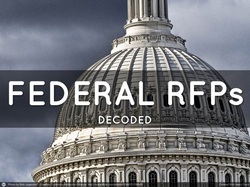Federal Government RFP Analysis

Government contractors spend millions of dollars on proposal consultants, many of whom might be good writers, but know very little about the Federal Acquisition Regulations (FAR). Hiring the wrong consultant could prevent you from getting through the Contracting Officer's initial review gate, and if you do, your proposal must comply with the FAR requirements specified in the request for proposal (RFP).
Federal RFP documents are complex and often released with errors that confuse potential bidders. Taking a systematic approach to RFP analysis will speed up the process and ensure that you focus on the right details. If you overlook even a single critical requirement, you’ve put at risk thousands and even millions of your company’s B&P dollars. Beyond that, consider the personal sacrifices made by individual team members as they give up evenings, nights and weekends to develop a proposal.
This guide walks through the federal RFP structure, officially called the Uniform Commercial Format (UCF) which consists of Parts I through IV distributed across Sections A through M. The UCF format is required by FAR Part 15 Contracting by Negotiation and is typically used for negotiated federal contracts valued at more than $150,000. The UCF format is instantly recognizable because of labeling convention: Section A through M. Some federal agencies take exception to this format including FAA and USPS. The agency taking exception might choose to use a numerical outline structure for the RFP sections, but the content will be similar: technical requirements, instructions, evaluation criteria and special contract provisions.
Proposals that do not adhere to RFP instructions are often eliminated early in the process. Usually, elimination in the early stage can be attributed to careless errors. By following the tips contained in this guide, you can mitigate the risk of early elimination due to careless errors.
The UCF consists of four parts (I - IV):
Part I – The Schedule
(becomes part of the contract)
Section A - Solicitation/contract form (e.g., SF33, SF1449, SF1442)
Section B - Supplies or services and prices/costs
Section C- Description/specifications/statement of work
Section D - Packaging and marking
Section E - Inspection and acceptance
Section F - Deliveries or performance
Section G - Contract administration data
Section H - Special contract requirements
Part II – Contract Clauses
(becomes part of the contract)
Section I - Contract clauses
Part III – List of Documents, Exhibits, and Other Attachments
(becomes part of the contract)
Section J - List of attachments
Part IV – Representations and Instructions
(DOES NOT become part of the contract)
Section K - Representations, certifications, and other statements of offerors or respondents
Section L - Instructions, conditions, and notices to offerors or respondents
Section M - Evaluation factors for award
Go to RFP Cover Letter | View Bibliography
Federal RFP documents are complex and often released with errors that confuse potential bidders. Taking a systematic approach to RFP analysis will speed up the process and ensure that you focus on the right details. If you overlook even a single critical requirement, you’ve put at risk thousands and even millions of your company’s B&P dollars. Beyond that, consider the personal sacrifices made by individual team members as they give up evenings, nights and weekends to develop a proposal.
This guide walks through the federal RFP structure, officially called the Uniform Commercial Format (UCF) which consists of Parts I through IV distributed across Sections A through M. The UCF format is required by FAR Part 15 Contracting by Negotiation and is typically used for negotiated federal contracts valued at more than $150,000. The UCF format is instantly recognizable because of labeling convention: Section A through M. Some federal agencies take exception to this format including FAA and USPS. The agency taking exception might choose to use a numerical outline structure for the RFP sections, but the content will be similar: technical requirements, instructions, evaluation criteria and special contract provisions.
Proposals that do not adhere to RFP instructions are often eliminated early in the process. Usually, elimination in the early stage can be attributed to careless errors. By following the tips contained in this guide, you can mitigate the risk of early elimination due to careless errors.
The UCF consists of four parts (I - IV):
Part I – The Schedule
(becomes part of the contract)
Section A - Solicitation/contract form (e.g., SF33, SF1449, SF1442)
Section B - Supplies or services and prices/costs
Section C- Description/specifications/statement of work
Section D - Packaging and marking
Section E - Inspection and acceptance
Section F - Deliveries or performance
Section G - Contract administration data
Section H - Special contract requirements
Part II – Contract Clauses
(becomes part of the contract)
Section I - Contract clauses
Part III – List of Documents, Exhibits, and Other Attachments
(becomes part of the contract)
Section J - List of attachments
Part IV – Representations and Instructions
(DOES NOT become part of the contract)
Section K - Representations, certifications, and other statements of offerors or respondents
Section L - Instructions, conditions, and notices to offerors or respondents
Section M - Evaluation factors for award
Go to RFP Cover Letter | View Bibliography